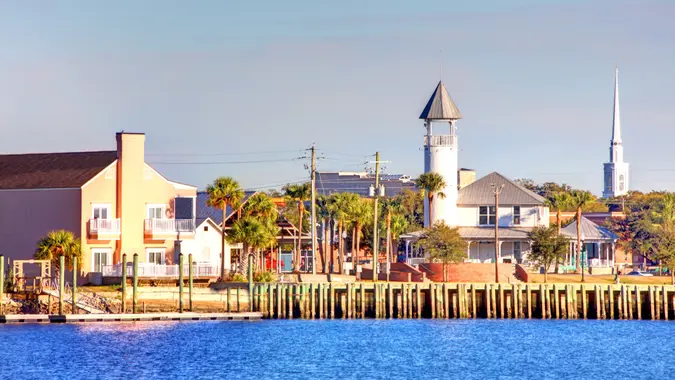Advertiser Disclosure
GOBankingRates works with many financial advertisers to showcase their products and services to our audiences. These brands compensate us to advertise their products in ads across our site. This compensation may impact how and where products appear on this site. We are not a comparison-tool and these offers do not represent all available deposit, investment, loan or credit products.
How Far a $100K Salary Goes on the East Coast
 Written by
Heather Altamirano
Written by
Heather Altamirano
 Edited by
Chris Cluff
Edited by
Chris Cluff

Commitment to Our Readers
GOBankingRates' editorial team is committed to bringing you unbiased reviews and information. We use data-driven methodologies to evaluate financial products and services - our reviews and ratings are not influenced by advertisers. You can read more about our editorial guidelines and our products and services review methodology.

20 YearsHelping You Live Richer

Reviewed by Experts

Trusted by Millions of Readers
The East Coast has an undeniable charm. From quaint seaside towns to historic architecture and lively cities, the region is rich in history, unique traditions and cultural experiences. There are many reasons to live on the East Coast, but you need a substantial income to live comfortably in several areas.
You might think a $100,000 salary would be good enough to live anywhere, but it’s not quite enough in some Eastern states. GOBankingRates used data from the Bureau of Labor Statistics and the Missouri Economic Research and Information Center to compile a list of the 14 Eastern states’ cost-of-living indexes (100 equals the national average). See how far $100,000 goes in the East.
Connecticut
- Cost-of-living index: 113.5
- Annual expenditures: $102,918
- % of annual expenditures that $100K covers: 97.2%
Connecticut has close-knit communities and a quieter lifestyle, while also providing close access to New York and Boston. A hundred grand falls slightly short of covering all annual expenditures. That is partly because utilities average $562 a month, fourth highest in the nation.
Delaware
- Cost-of-living index: 103.5
- Annual expenditures: $93,851
- % of annual expenditures that $100K covers: 106.6%
Known for its picturesque beaches, relaxed lifestyle and thriving arts scene, Delaware is a beautiful place to live. There’s no state sales tax, and $100,000 covers all annual expenditures as cost of living is just barely over the U.S. average.
Florida
- Cost-of-living index: 102.0
- Annual expenditures: $92,491
- % of annual expenditures that $100K covers: 108.1%
With its year-round great weather, no state income tax and a slew of outdoor activities, Florida is a retirement haven. Residents pay just 90% of the national median for healthcare, which is the sixth-least expensive in the country.
Georgia
- Cost-of-living index: 91.7
- Annual expenditures: $83,151
- % of annual expenditures that $100K covers: 120.3%
Georgia has everything from a gorgeous diverse landscape, a growing tech hub and booming film industry, a family-friendly environment and one-of-a-kind cities. The Peach State has a cost-of-living index of 91.7, groceries are the 14th lowest in the country, but utilities are the 10th most expensive with a monthly average of $454.
Maine
- Cost-of-living index: 113.4
- Annual expenditures: $102,828
- % of annual expenditures that $100K covers: 97.3%
There are plenty of things to love about Maine: the fresh seafood, coastal living, stunning scenery, fall foliage and mostly affordable prices. Housing is 33.2% higher than average — the country’s ninth-highest index.
Maryland
- Cost-of-living index: 114.9
- Annual expenditures: $104,188
- % of annual expenditures that $100K covers: 96.0%
Maryland is home to pretty sandy beaches, foodie-worthy restaurants and top-tier healthcare such as Johns Hopkins Hospital. A hundred thousand dollars falls a little shy of covering annual expenditures. Housing costs are the nation’s eighth highest and residents pay 5% above the national median for groceries.
Massachusetts
- Cost-of-living index: 145.1
- Annual expenditures: $131,572
- % of annual expenditures that $100K covers: 76.0%
Massachusetts is a fascinating blend of history, striking natural beauty, adored sports teams and a vibrant social scene. But it’s not cheap. People who live in the state pay more than double for housing and healthcare, which ranks second-most expensive in the country at $871 per month.
New Hampshire
- Cost-of-living index: 110.1
- Annual expenditures: $99,835
- % of annual expenditures that $100K covers: 100.2%
New Hampshire has a small-town, inviting appeal and a slower-paced lifestyle, but is in close proximity to larger cities such as Boston for a fun night on the town. It can also be somewhat cost-effective, thanks to no state income tax and sales tax. A $100,000 income will barely cover typical annual expenditures and the state ranks No. 15 for the most expensive housing costs, with residents paying $1,624 each month on average.
New Jersey
- Cost-of-living index: 114.8
- Annual expenditures: $104,097
- % of annual expenditures that $100K covers: 96.1%
In New Jersey, $100,000 is about 4% short of covering all expenses. Healthcare is ranked No. 13 for most expensive and housing is the sixth most expensive in the country — just over $2,000 a month.
New York
- Cost-of-living index: 124.7
- Annual expenditures: $113,074
- % of annual expenditures that $100K covers: 88.4%
The cost of living in New York varies depending on where you live, but overall $100,000 is not enough to maintain a comfortable lifestyle. The state has the fourth-highest housing costs, ranks No. 11 for most expensive groceries and 10th most expensive for healthcare.
North Carolina
- Cost-of-living index: 97.8
- Annual expenditures: $88,682
- % of annual expenditures that $100K covers: 112.8%
North Carolina is a good balance of cities and scenic beauty. Residents can enjoy both the Appalachian Mountains and the Atlantic Coast at a very affordable cost of living. The state has the ninth-highest healthcare costs but ranks below the national median for groceries (97.7), housing (94.9), utilities (94.7) and transportation (92.9).
Pennsylvania
- Cost-of-living index: 97.5
- Annual expenditures: $88,410
- % of annual expenditures that $100K covers: 113.1%
The Keystone State has the nation’s 12th cheapest grocery expenditures, scoring a 97.4. Utility expenditures are the 11th most expensive.
Rhode Island
- Cost-of-living index: 109.3
- Annual expenditures: $99,110
- % of annual expenditures that $100K covers: 100.9%
Rhode Island is a nice mix of modern amenities and historic charm, but $100,000 doesn’t stretch far. The six-figure wage covers all annual expenses even though utilities are the fifth highest in the country.
South Carolina
- Cost-of-living index: 94.6
- Annual expenditures: $85,780
- % of annual expenditures that $100K covers: 116.6%
South Carolina is known for being warm and welcoming and a laid-back coastal atmosphere, and $100,000 leaves an extra 17% for other spending. Healthcare costs are affordable — the 15th cheapest in the nation.
Vermont
- Cost-of-living index: 113.7
- Annual expenditures: $103,100
- % of annual expenditures that $100K covers: 97.0%
Vermont ranks in the top 12 for the most expensive groceries (fifth), housing (11th), utilities (ninth) and healthcare (sixth).
Virginia
- Cost-of-living index: 101.4
- Annual expenditures: $91,946
- % of annual expenditures that $100K covers: 108.8%
From energetic cities to peaceful mountain retreats and coastal towns, there is something for everyone in Virginia. A yearly salary of $100,000 leaves 8.8% for other spending.
West Virginia
- Cost-of-living index: 88.6
- Annual expenditures: $80,340
- % of annual expenditures that $100K covers: 124.5%
Cost of living in West Virginia is the cheapest among the East Coast states. Residents pay about 11% less than people in other states, so a $100,000 salary leaves a 24.5% cushion. Monthly grocery expenditures are $568 on average, tied for seventh lowest in the country. Healthcare costs are the nation’s 12th lowest, at $592 a month.
Methodology: For this analysis, GOBankingRates first sourced the national average annual expenditures for people with incomes between $100,000 and $149,999 from the Bureau of Labor Statistics’ 2023 Consumer Expenditure Survey data. GBR then created state-level annual expenditure estimates by multiplying the national figure by each state’s cost-of-living index for Q1 2025 from the Missouri Economic Research and Information Center. Finally, GBR determined what percentage of annual expenditures is covered by $100,000 by dividing $100,000 by each state’s average annual expenditures estimate. All data was collected on and is up to date as of July 29, 2025.
Share This Article:




You May Also Like

People Living in These 10 States Might Struggle With Money -- See If Your State Makes the List
December 18, 2025
7 min Read

I'm a Financial Advisor: 5 Worst Things You Can Do for Your Finances in 2026
December 16, 2025
7 min Read

7 Lessons To Learn If You Want To Become a Millionaire, According To Vincent Chan
December 16, 2025
7 min Read


Wealthy Americans Plan To Keep Spending and Investing Steady in 2026: Should You?
December 12, 2025
7 min Read


22 States in or Near a Recession Right Now -- and What It Means for Residents
December 17, 2025
7 min Read

I Asked ChatGPT How Many Americans Qualify for the Trump $2K Dividend -- Here's What It Said
December 17, 2025
7 min Read


I'm a Financial Advisor: 10 Awesome Things You Can Do for Your Finances in 2026
December 15, 2025
7 min Read



5 Types of People Struggling to Pay Bills Right Now -- Are You One of Them?
December 17, 2025
7 min Read

Skip College, Not the Paycheck: These 5 No-Degree Medical Jobs Pay Well
December 16, 2025
7 min Read
Questions Around The Economy
Make your money work for you
Get the latest news on investing, money, and more with our free newsletter.
By subscribing, you agree to our Terms of Use and Privacy Policy. Unsubscribe at any time.


Thanks!
You're now subscribed to our newsletter.
Check your inbox for more details.



Sending you timely financial stories that you can bank on.
Sign up for our daily newsletter for the latest financial news and trending topics.
For our full Privacy Policy, click here.
Looks like you're using an adblocker
Please disable your adblocker to enjoy the optimal web experience and access the quality content you appreciate from GOBankingRates.
- AdBlock / uBlock / Brave
- Click the ad blocker extension icon to the right of the address bar
- Disable on this site
- Refresh the page
- Firefox / Edge / DuckDuckGo
- Click on the icon to the left of the address bar
- Disable Tracking Protection
- Refresh the page
- Ghostery
- Click the blue ghost icon to the right of the address bar
- Disable Ad-Blocking, Anti-Tracking, and Never-Consent
- Refresh the page




